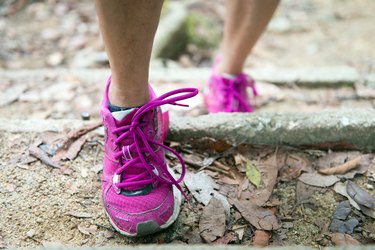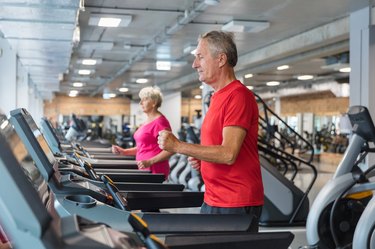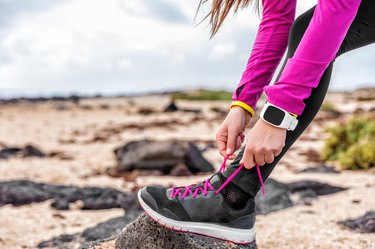
Getting fit, improving your mental and physical health and perhaps even losing weight can be as simple as putting one foot in front of the other. Walking is a free and convenient way to get and stay active, whether you want to start exercising or you need a low-impact cross-training or active recovery workout.
From making a 20-minute walk part of your morning routine to crushing 12-, 20- or even 50-mile treks, you can tailor your workouts to match your preferences and schedule. Enjoy walking on the treadmill? Set the incline to at least 1 percent and get to it. Prefer to spread your steps out throughout the day? You might benefit from a fitness tracker. Whatever your goal, there's a plan to get you there, and we've broken them all down for you here.
Why You Should Go for a Walk Right Now

If the ease and convenience (and low cost) of walking don't convince you to lace up your sneakers, perhaps a little science will. Aside from getting your heart rate up and your muscles firing, this low-intensity form of exercise has been linked to:
- Lower rates of depression
- Less stress
- Longer life expectancy
- Increased energy
- Decreased lower back pain
- Easier weight management
Plus, you don't need to log hours and hours of activity or accrue a massive amount of daily steps to reap theses benefits. You can start to feel healthier and more energized with just a few 10-minute walks, which can make the process of getting fit more manageable.
Need more convincing? Here are all the science-backed benefits of walking.
How to Start a Walking Program

While just going for a walk whenever you feel like it is still good for you, if you want to make the most of the steps you're taking, it's recommended you establish a more concrete schedule. But rest easy: Because walking is something you probably do every day anyway, getting started can be as simple as deciding when, where and for how long.
Walking briskly for 30 minutes, five times a week is a good place to start, according to the Mayo Clinic. And aim for at least 100 to 130 steps per minute, according to a January 2019 study from International Journal of Behavioral Nutrition and Physical Activity. You'll know that you're keeping the right pace if you're breathing hard but are still able to carry on a conversation.
Not sure where to start? Here are the steps you'll want to take.
Walking to Lose Weight and Get Fit

When you're trying to lose weight, you might think you need to do something strenuous like running or HIIT workouts every single day in order to see any results. While those are great options if they appeal to you, they're not the only forms of exercise that can help you drop pounds.
Because weight loss essentially comes down to burning more calories than you consume, walking pairs quite nicely with a nutritious, reduced-calorie diet to help you reach your weight-loss goal. Depending on your weight and speed, walking burns about 150 to 200 calories in 30 minutes. But the most important part of walking for weight loss is making sure you enjoy it — or at the very least find it convenient enough to stick with.
Is weight loss your goal? Walking can help get you there.
Transition Your Walking Workouts to the Treadmill

Some people might call the treadmill the "dreadmill," but it doesn't have to be a monotonous slog. Start by cueing up your favorite workout playlist, trying out the new podcast all your friends have been recommending or starting a new Netflix show from your queue and get walking.
And there's good news for anyone debating between the treadmill and walking outside: A May 2019 review published in Sports Medicine found that there's not much difference between the two. In both cases, exercisers' perceived effort and oxygen intake (an indicator of how hard they were working) were about the same.
The treadmill is an easy, convenient way to lose weight, get fit and tone up.
Go for a Long Walk in the Great Outdoors

While you might think long-distance walking is just another name for hiking, it's so much more than that. The trend started in 1963 when then-attorney general Robert F. Kennedy walked 50 miles from Washington, DC, to Harpers Ferry, West Virginia, reportedly only wearing his Oxfords. Today, plenty of people take the challenge to walk all the way across the United States.
When your usual walk around the block or your weekend hike isn't enough, channel your inner Forest Gump and go long! Make sure you have some sturdy, comfortable shoes (lots of long-distance walkers prefer running shoes) by getting fitted at a local running store where they can analyze your feet and gait. Then carve out time for a good warm up with plenty of dynamic stretches and let someone know where you're going (safety first!).
If you're game to go the distance, learn how to get started with long-distance walking.
Add Intervals to Your Walks

High-intensity interval training might seem like it's only for high-impact workouts, but you can incorporate it into any form of exercise. It's the perfect way to reap the benefits of longer, steady-state walks in a fraction of the time.
You won't even have to go full speed ahead if you don't want to. You can add intervals to your walking by going uphill or simply picking up the pace just a bit (don't hold onto the handrails if you're on the treadmill, though!). Putting forth that little bit of extra effort burns more calories and challenges your muscles in a new way. And over time, that can add up to an improvement in your cardiovascular fitness and perhaps even lead to weight loss.
You'll want to try this incredibly efficient walking interval workout.
Get the Right Gear

Sure, you could toss on a pair of sneakers you bought 10 years ago that barely have any tread left. But if you plan on logging some serious mileage, having a pair of walking shoes designed for exercise is a must. Because while your Chucks are comfy for running errands, you'll want extra support and cushioning when you're working out.
If you're going to be walking a lot, it can also be helpful to have a device that tracks all those steps for you, too. When it comes to step counters and fitness trackers, you have a few choices: old-school pedometers, smartphone apps and wearable devices. Figure out what you want in a tracker and weigh your options before you commit to one.